Business Finance Case Study: Costing System, Variance Analysis
VerifiedAdded on 2023/06/14
|13
|2342
|128
Case Study
AI Summary
This assignment presents a comprehensive case study in business finance, focusing on costing systems and variance analysis. It begins with an introduction to financial reporting and its importance in monitoring a corporation's financial affairs. The study calculates contribution per unit, break-even points in units and sales, and margin of safety. It includes a memo discussing the importance of contribution in strategic planning and its impact on the margin of safety. The second part of the study demonstrates an understanding of the standard costing system and variance analysis, including the advantages of conventional costs and the phases of variation assessment. It calculates material, labor, and overhead cost variances, providing a detailed analysis of each component. The conclusion emphasizes the importance of various finance-related methodologies and the need for companies to maintain a close watch on variables to make accurate and influential decisions. Desklib provides access to this and other solved assignments to aid students in their studies.
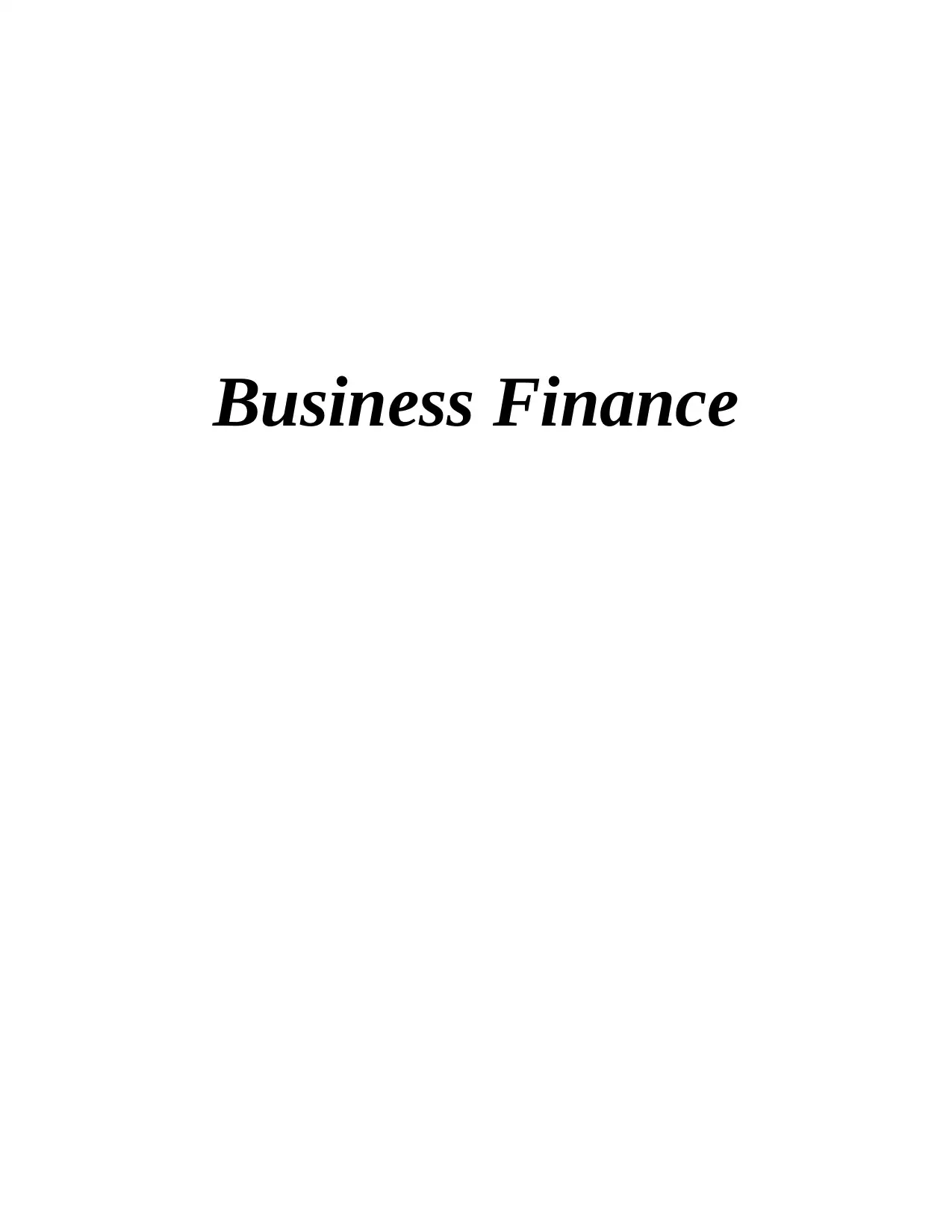
Business Finance
Paraphrase This Document
Need a fresh take? Get an instant paraphrase of this document with our AI Paraphraser

Contents
Contents...........................................................................................................................................2
INTRODUCTION...........................................................................................................................1
PART A...........................................................................................................................................1
PART 2............................................................................................................................................4
CONCLUSION................................................................................................................................9
REFERENCES..............................................................................................................................11
Contents...........................................................................................................................................2
INTRODUCTION...........................................................................................................................1
PART A...........................................................................................................................................1
PART 2............................................................................................................................................4
CONCLUSION................................................................................................................................9
REFERENCES..............................................................................................................................11
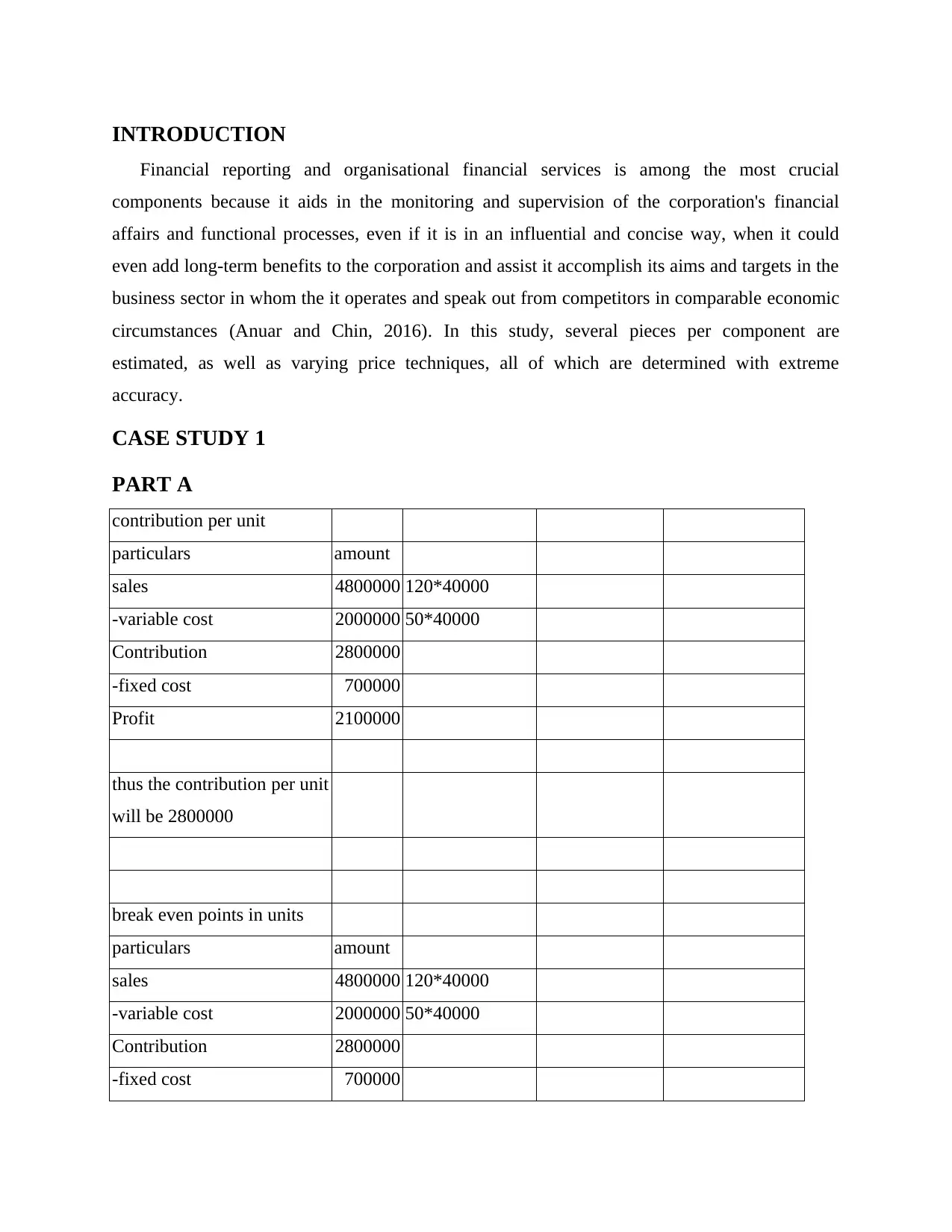
INTRODUCTION
Financial reporting and organisational financial services is among the most crucial
components because it aids in the monitoring and supervision of the corporation's financial
affairs and functional processes, even if it is in an influential and concise way, when it could
even add long-term benefits to the corporation and assist it accomplish its aims and targets in the
business sector in whom the it operates and speak out from competitors in comparable economic
circumstances (Anuar and Chin, 2016). In this study, several pieces per component are
estimated, as well as varying price techniques, all of which are determined with extreme
accuracy.
CASE STUDY 1
PART A
contribution per unit
particulars amount
sales 4800000 120*40000
-variable cost 2000000 50*40000
Contribution 2800000
-fixed cost 700000
Profit 2100000
thus the contribution per unit
will be 2800000
break even points in units
particulars amount
sales 4800000 120*40000
-variable cost 2000000 50*40000
Contribution 2800000
-fixed cost 700000
Financial reporting and organisational financial services is among the most crucial
components because it aids in the monitoring and supervision of the corporation's financial
affairs and functional processes, even if it is in an influential and concise way, when it could
even add long-term benefits to the corporation and assist it accomplish its aims and targets in the
business sector in whom the it operates and speak out from competitors in comparable economic
circumstances (Anuar and Chin, 2016). In this study, several pieces per component are
estimated, as well as varying price techniques, all of which are determined with extreme
accuracy.
CASE STUDY 1
PART A
contribution per unit
particulars amount
sales 4800000 120*40000
-variable cost 2000000 50*40000
Contribution 2800000
-fixed cost 700000
Profit 2100000
thus the contribution per unit
will be 2800000
break even points in units
particulars amount
sales 4800000 120*40000
-variable cost 2000000 50*40000
Contribution 2800000
-fixed cost 700000
⊘ This is a preview!⊘
Do you want full access?
Subscribe today to unlock all pages.

Trusted by 1+ million students worldwide
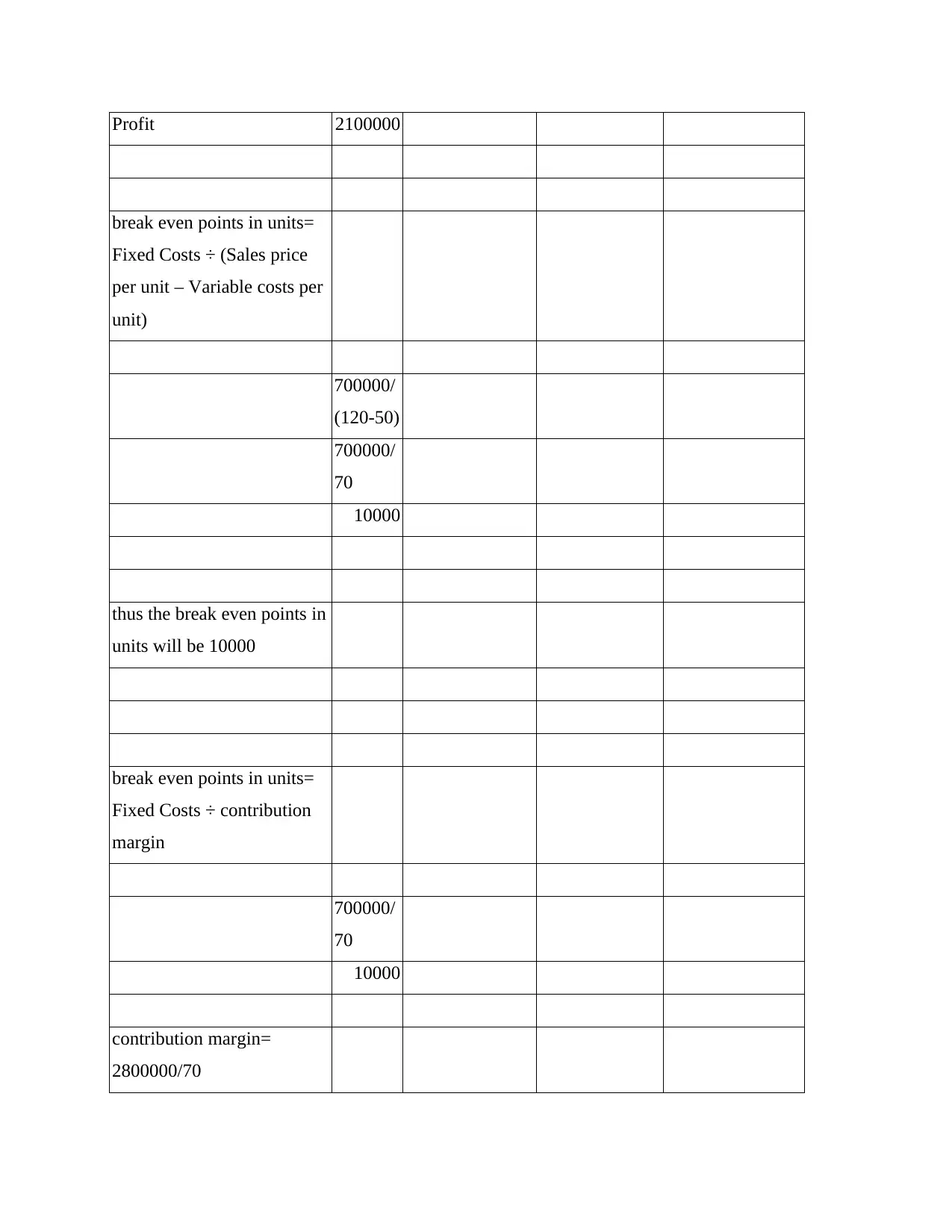
Profit 2100000
break even points in units=
Fixed Costs ÷ (Sales price
per unit – Variable costs per
unit)
700000/
(120-50)
700000/
70
10000
thus the break even points in
units will be 10000
break even points in units=
Fixed Costs ÷ contribution
margin
700000/
70
10000
contribution margin=
2800000/70
break even points in units=
Fixed Costs ÷ (Sales price
per unit – Variable costs per
unit)
700000/
(120-50)
700000/
70
10000
thus the break even points in
units will be 10000
break even points in units=
Fixed Costs ÷ contribution
margin
700000/
70
10000
contribution margin=
2800000/70
Paraphrase This Document
Need a fresh take? Get an instant paraphrase of this document with our AI Paraphraser
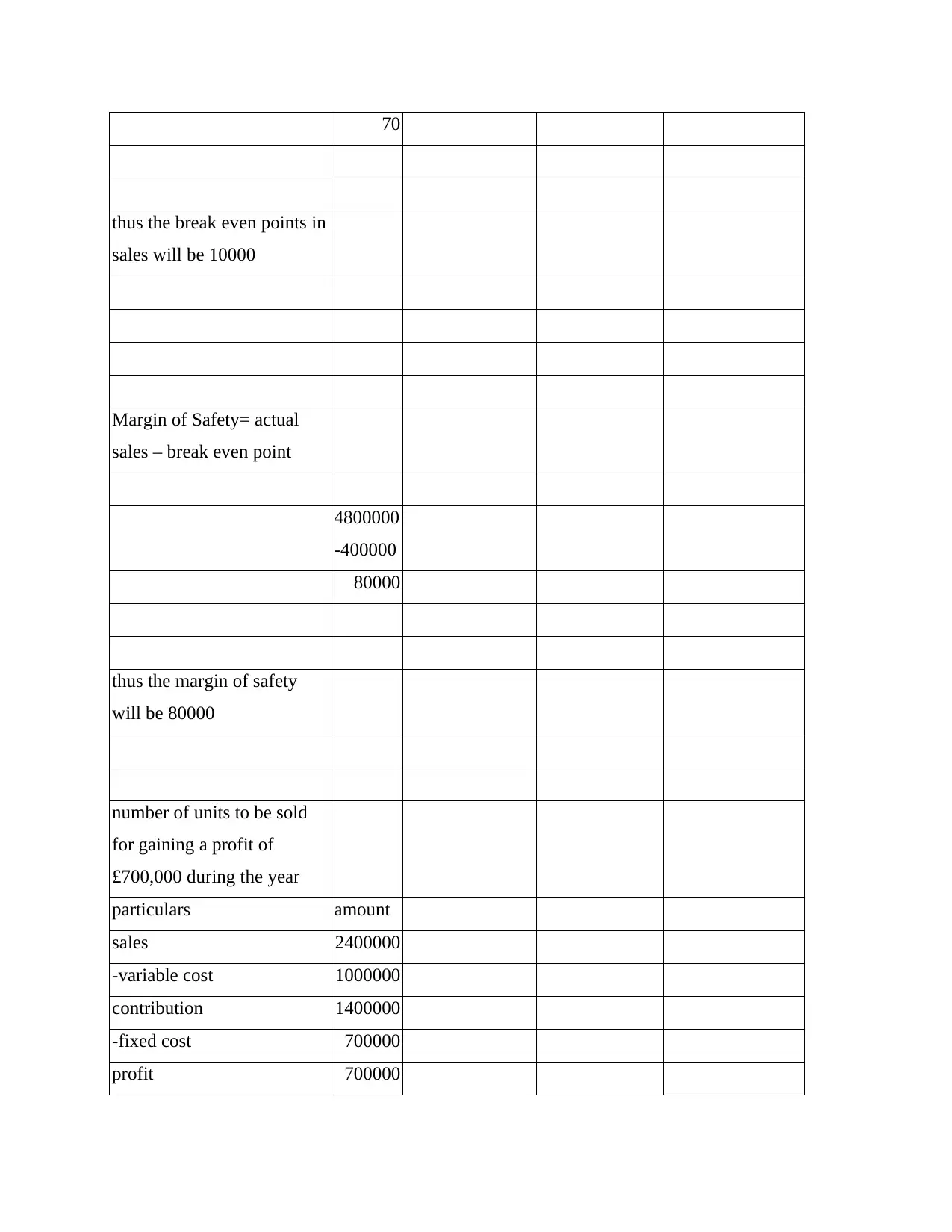
70
thus the break even points in
sales will be 10000
Margin of Safety= actual
sales – break even point
4800000
-400000
80000
thus the margin of safety
will be 80000
number of units to be sold
for gaining a profit of
£700,000 during the year
particulars amount
sales 2400000
-variable cost 1000000
contribution 1400000
-fixed cost 700000
profit 700000
thus the break even points in
sales will be 10000
Margin of Safety= actual
sales – break even point
4800000
-400000
80000
thus the margin of safety
will be 80000
number of units to be sold
for gaining a profit of
£700,000 during the year
particulars amount
sales 2400000
-variable cost 1000000
contribution 1400000
-fixed cost 700000
profit 700000
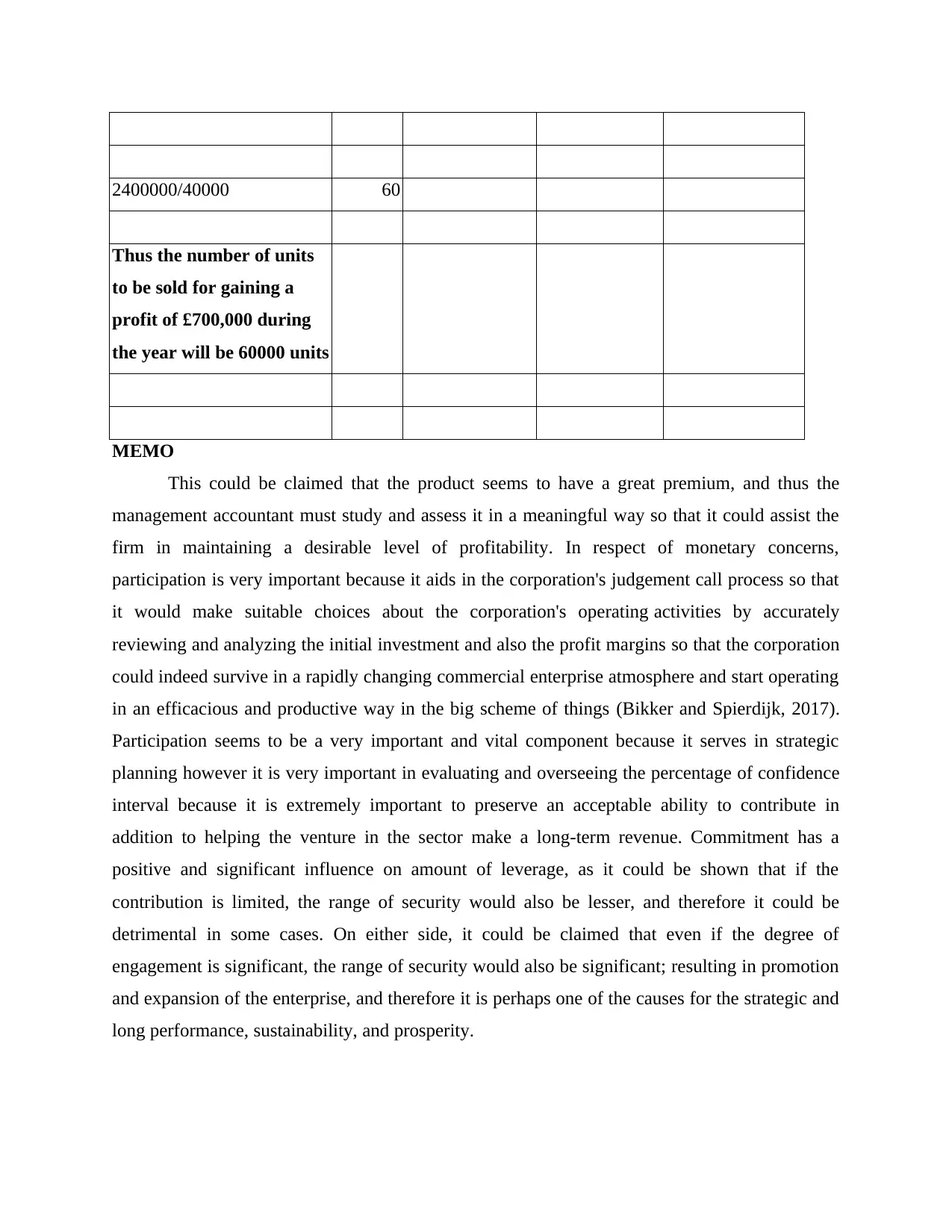
2400000/40000 60
Thus the number of units
to be sold for gaining a
profit of £700,000 during
the year will be 60000 units
MEMO
This could be claimed that the product seems to have a great premium, and thus the
management accountant must study and assess it in a meaningful way so that it could assist the
firm in maintaining a desirable level of profitability. In respect of monetary concerns,
participation is very important because it aids in the corporation's judgement call process so that
it would make suitable choices about the corporation's operating activities by accurately
reviewing and analyzing the initial investment and also the profit margins so that the corporation
could indeed survive in a rapidly changing commercial enterprise atmosphere and start operating
in an efficacious and productive way in the big scheme of things (Bikker and Spierdijk, 2017).
Participation seems to be a very important and vital component because it serves in strategic
planning however it is very important in evaluating and overseeing the percentage of confidence
interval because it is extremely important to preserve an acceptable ability to contribute in
addition to helping the venture in the sector make a long-term revenue. Commitment has a
positive and significant influence on amount of leverage, as it could be shown that if the
contribution is limited, the range of security would also be lesser, and therefore it could be
detrimental in some cases. On either side, it could be claimed that even if the degree of
engagement is significant, the range of security would also be significant; resulting in promotion
and expansion of the enterprise, and therefore it is perhaps one of the causes for the strategic and
long performance, sustainability, and prosperity.
Thus the number of units
to be sold for gaining a
profit of £700,000 during
the year will be 60000 units
MEMO
This could be claimed that the product seems to have a great premium, and thus the
management accountant must study and assess it in a meaningful way so that it could assist the
firm in maintaining a desirable level of profitability. In respect of monetary concerns,
participation is very important because it aids in the corporation's judgement call process so that
it would make suitable choices about the corporation's operating activities by accurately
reviewing and analyzing the initial investment and also the profit margins so that the corporation
could indeed survive in a rapidly changing commercial enterprise atmosphere and start operating
in an efficacious and productive way in the big scheme of things (Bikker and Spierdijk, 2017).
Participation seems to be a very important and vital component because it serves in strategic
planning however it is very important in evaluating and overseeing the percentage of confidence
interval because it is extremely important to preserve an acceptable ability to contribute in
addition to helping the venture in the sector make a long-term revenue. Commitment has a
positive and significant influence on amount of leverage, as it could be shown that if the
contribution is limited, the range of security would also be lesser, and therefore it could be
detrimental in some cases. On either side, it could be claimed that even if the degree of
engagement is significant, the range of security would also be significant; resulting in promotion
and expansion of the enterprise, and therefore it is perhaps one of the causes for the strategic and
long performance, sustainability, and prosperity.
⊘ This is a preview!⊘
Do you want full access?
Subscribe today to unlock all pages.

Trusted by 1+ million students worldwide
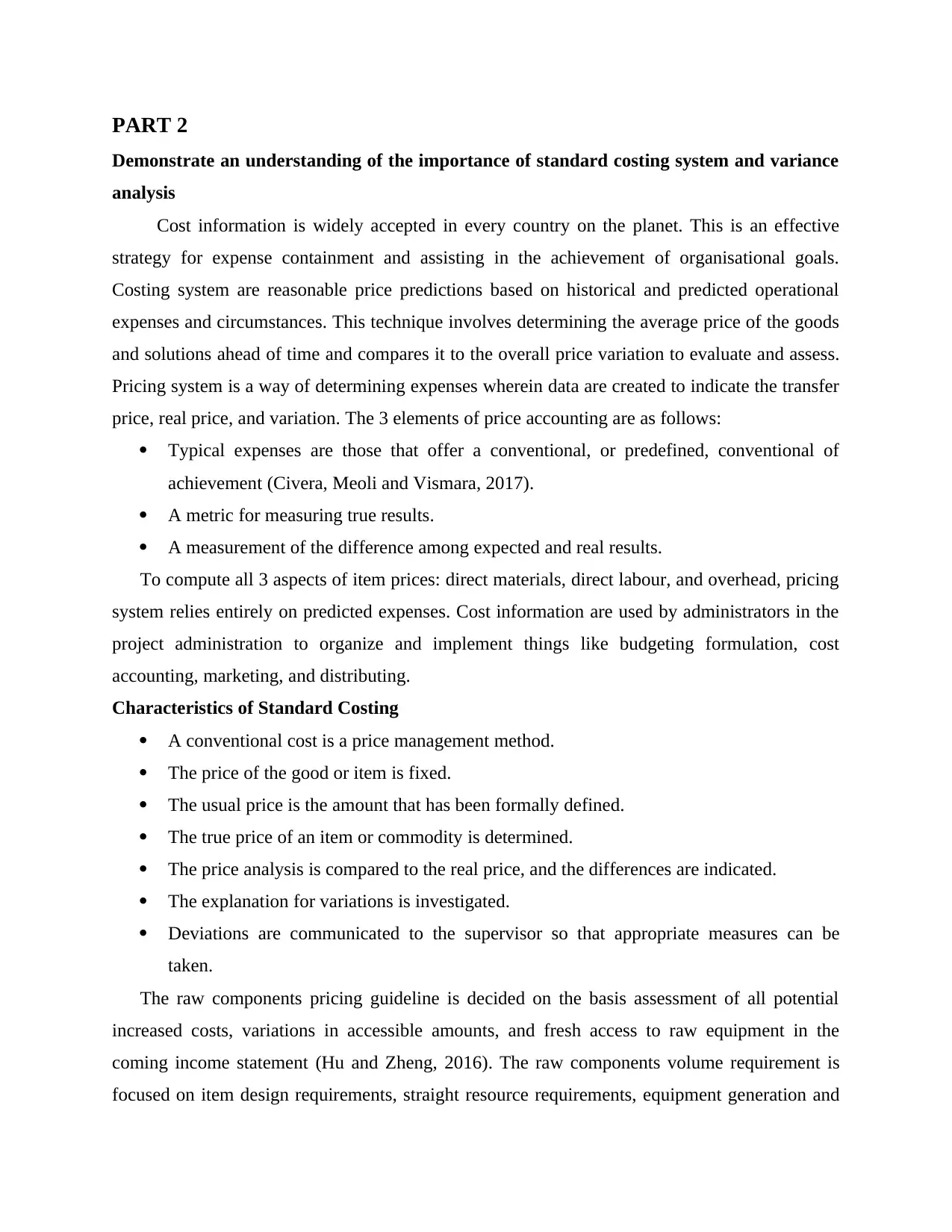
PART 2
Demonstrate an understanding of the importance of standard costing system and variance
analysis
Cost information is widely accepted in every country on the planet. This is an effective
strategy for expense containment and assisting in the achievement of organisational goals.
Costing system are reasonable price predictions based on historical and predicted operational
expenses and circumstances. This technique involves determining the average price of the goods
and solutions ahead of time and compares it to the overall price variation to evaluate and assess.
Pricing system is a way of determining expenses wherein data are created to indicate the transfer
price, real price, and variation. The 3 elements of price accounting are as follows:
Typical expenses are those that offer a conventional, or predefined, conventional of
achievement (Civera, Meoli and Vismara, 2017).
A metric for measuring true results.
A measurement of the difference among expected and real results.
To compute all 3 aspects of item prices: direct materials, direct labour, and overhead, pricing
system relies entirely on predicted expenses. Cost information are used by administrators in the
project administration to organize and implement things like budgeting formulation, cost
accounting, marketing, and distributing.
Characteristics of Standard Costing
A conventional cost is a price management method.
The price of the good or item is fixed.
The usual price is the amount that has been formally defined.
The true price of an item or commodity is determined.
The price analysis is compared to the real price, and the differences are indicated.
The explanation for variations is investigated.
Deviations are communicated to the supervisor so that appropriate measures can be
taken.
The raw components pricing guideline is decided on the basis assessment of all potential
increased costs, variations in accessible amounts, and fresh access to raw equipment in the
coming income statement (Hu and Zheng, 2016). The raw components volume requirement is
focused on item design requirements, straight resource requirements, equipment generation and
Demonstrate an understanding of the importance of standard costing system and variance
analysis
Cost information is widely accepted in every country on the planet. This is an effective
strategy for expense containment and assisting in the achievement of organisational goals.
Costing system are reasonable price predictions based on historical and predicted operational
expenses and circumstances. This technique involves determining the average price of the goods
and solutions ahead of time and compares it to the overall price variation to evaluate and assess.
Pricing system is a way of determining expenses wherein data are created to indicate the transfer
price, real price, and variation. The 3 elements of price accounting are as follows:
Typical expenses are those that offer a conventional, or predefined, conventional of
achievement (Civera, Meoli and Vismara, 2017).
A metric for measuring true results.
A measurement of the difference among expected and real results.
To compute all 3 aspects of item prices: direct materials, direct labour, and overhead, pricing
system relies entirely on predicted expenses. Cost information are used by administrators in the
project administration to organize and implement things like budgeting formulation, cost
accounting, marketing, and distributing.
Characteristics of Standard Costing
A conventional cost is a price management method.
The price of the good or item is fixed.
The usual price is the amount that has been formally defined.
The true price of an item or commodity is determined.
The price analysis is compared to the real price, and the differences are indicated.
The explanation for variations is investigated.
Deviations are communicated to the supervisor so that appropriate measures can be
taken.
The raw components pricing guideline is decided on the basis assessment of all potential
increased costs, variations in accessible amounts, and fresh access to raw equipment in the
coming income statement (Hu and Zheng, 2016). The raw components volume requirement is
focused on item design requirements, straight resource requirements, equipment generation and
Paraphrase This Document
Need a fresh take? Get an instant paraphrase of this document with our AI Paraphraser
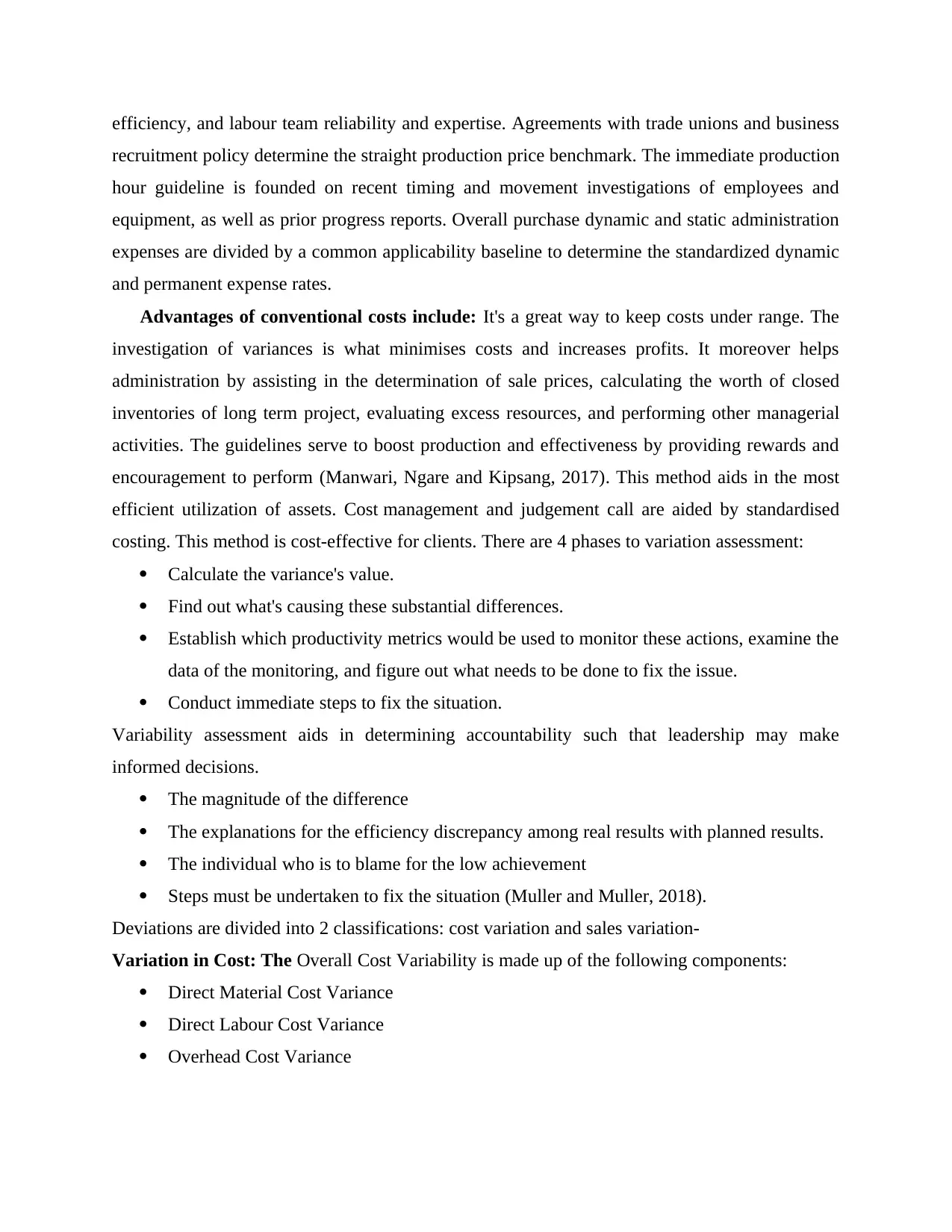
efficiency, and labour team reliability and expertise. Agreements with trade unions and business
recruitment policy determine the straight production price benchmark. The immediate production
hour guideline is founded on recent timing and movement investigations of employees and
equipment, as well as prior progress reports. Overall purchase dynamic and static administration
expenses are divided by a common applicability baseline to determine the standardized dynamic
and permanent expense rates.
Advantages of conventional costs include: It's a great way to keep costs under range. The
investigation of variances is what minimises costs and increases profits. It moreover helps
administration by assisting in the determination of sale prices, calculating the worth of closed
inventories of long term project, evaluating excess resources, and performing other managerial
activities. The guidelines serve to boost production and effectiveness by providing rewards and
encouragement to perform (Manwari, Ngare and Kipsang, 2017). This method aids in the most
efficient utilization of assets. Cost management and judgement call are aided by standardised
costing. This method is cost-effective for clients. There are 4 phases to variation assessment:
Calculate the variance's value.
Find out what's causing these substantial differences.
Establish which productivity metrics would be used to monitor these actions, examine the
data of the monitoring, and figure out what needs to be done to fix the issue.
Conduct immediate steps to fix the situation.
Variability assessment aids in determining accountability such that leadership may make
informed decisions.
The magnitude of the difference
The explanations for the efficiency discrepancy among real results with planned results.
The individual who is to blame for the low achievement
Steps must be undertaken to fix the situation (Muller and Muller, 2018).
Deviations are divided into 2 classifications: cost variation and sales variation-
Variation in Cost: The Overall Cost Variability is made up of the following components:
Direct Material Cost Variance
Direct Labour Cost Variance
Overhead Cost Variance
recruitment policy determine the straight production price benchmark. The immediate production
hour guideline is founded on recent timing and movement investigations of employees and
equipment, as well as prior progress reports. Overall purchase dynamic and static administration
expenses are divided by a common applicability baseline to determine the standardized dynamic
and permanent expense rates.
Advantages of conventional costs include: It's a great way to keep costs under range. The
investigation of variances is what minimises costs and increases profits. It moreover helps
administration by assisting in the determination of sale prices, calculating the worth of closed
inventories of long term project, evaluating excess resources, and performing other managerial
activities. The guidelines serve to boost production and effectiveness by providing rewards and
encouragement to perform (Manwari, Ngare and Kipsang, 2017). This method aids in the most
efficient utilization of assets. Cost management and judgement call are aided by standardised
costing. This method is cost-effective for clients. There are 4 phases to variation assessment:
Calculate the variance's value.
Find out what's causing these substantial differences.
Establish which productivity metrics would be used to monitor these actions, examine the
data of the monitoring, and figure out what needs to be done to fix the issue.
Conduct immediate steps to fix the situation.
Variability assessment aids in determining accountability such that leadership may make
informed decisions.
The magnitude of the difference
The explanations for the efficiency discrepancy among real results with planned results.
The individual who is to blame for the low achievement
Steps must be undertaken to fix the situation (Muller and Muller, 2018).
Deviations are divided into 2 classifications: cost variation and sales variation-
Variation in Cost: The Overall Cost Variability is made up of the following components:
Direct Material Cost Variance
Direct Labour Cost Variance
Overhead Cost Variance
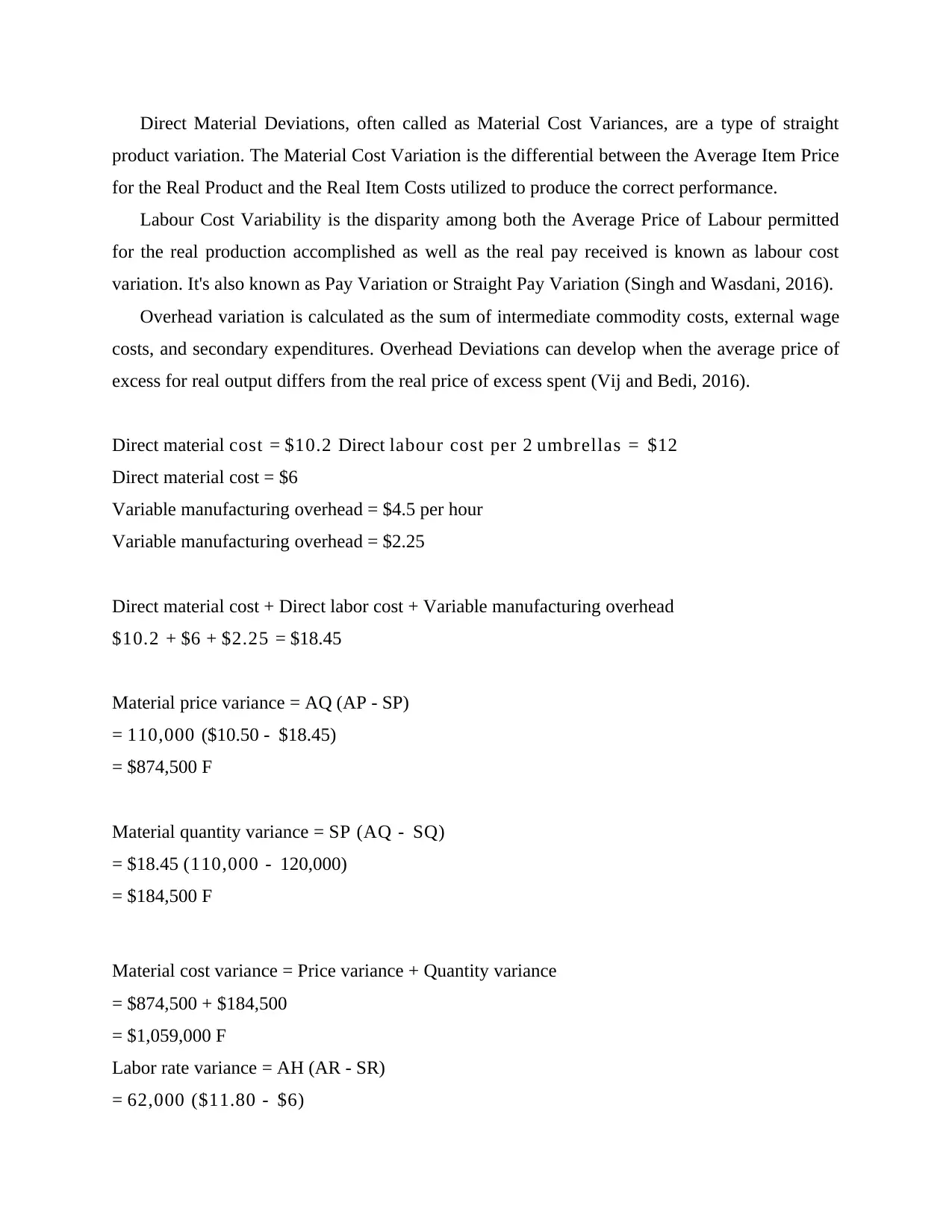
Direct Material Deviations, often called as Material Cost Variances, are a type of straight
product variation. The Material Cost Variation is the differential between the Average Item Price
for the Real Product and the Real Item Costs utilized to produce the correct performance.
Labour Cost Variability is the disparity among both the Average Price of Labour permitted
for the real production accomplished as well as the real pay received is known as labour cost
variation. It's also known as Pay Variation or Straight Pay Variation (Singh and Wasdani, 2016).
Overhead variation is calculated as the sum of intermediate commodity costs, external wage
costs, and secondary expenditures. Overhead Deviations can develop when the average price of
excess for real output differs from the real price of excess spent (Vij and Bedi, 2016).
Direct material cost = $10.2 Direct labour cost per 2 umbrellas = $12
Direct material cost = $6
Variable manufacturing overhead = $4.5 per hour
Variable manufacturing overhead = $2.25
Direct material cost + Direct labor cost + Variable manufacturing overhead
$10.2 + $6 + $2.25 = $18.45
Material price variance = AQ (AP - SP)
= 110,000 ($10.50 - $18.45)
= $874,500 F
Material quantity variance = SP (AQ - SQ)
= $18.45 (110,000 - 120,000)
= $184,500 F
Material cost variance = Price variance + Quantity variance
= $874,500 + $184,500
= $1,059,000 F
Labor rate variance = AH (AR - SR)
= 62,000 ($11.80 - $6)
product variation. The Material Cost Variation is the differential between the Average Item Price
for the Real Product and the Real Item Costs utilized to produce the correct performance.
Labour Cost Variability is the disparity among both the Average Price of Labour permitted
for the real production accomplished as well as the real pay received is known as labour cost
variation. It's also known as Pay Variation or Straight Pay Variation (Singh and Wasdani, 2016).
Overhead variation is calculated as the sum of intermediate commodity costs, external wage
costs, and secondary expenditures. Overhead Deviations can develop when the average price of
excess for real output differs from the real price of excess spent (Vij and Bedi, 2016).
Direct material cost = $10.2 Direct labour cost per 2 umbrellas = $12
Direct material cost = $6
Variable manufacturing overhead = $4.5 per hour
Variable manufacturing overhead = $2.25
Direct material cost + Direct labor cost + Variable manufacturing overhead
$10.2 + $6 + $2.25 = $18.45
Material price variance = AQ (AP - SP)
= 110,000 ($10.50 - $18.45)
= $874,500 F
Material quantity variance = SP (AQ - SQ)
= $18.45 (110,000 - 120,000)
= $184,500 F
Material cost variance = Price variance + Quantity variance
= $874,500 + $184,500
= $1,059,000 F
Labor rate variance = AH (AR - SR)
= 62,000 ($11.80 - $6)
⊘ This is a preview!⊘
Do you want full access?
Subscribe today to unlock all pages.

Trusted by 1+ million students worldwide
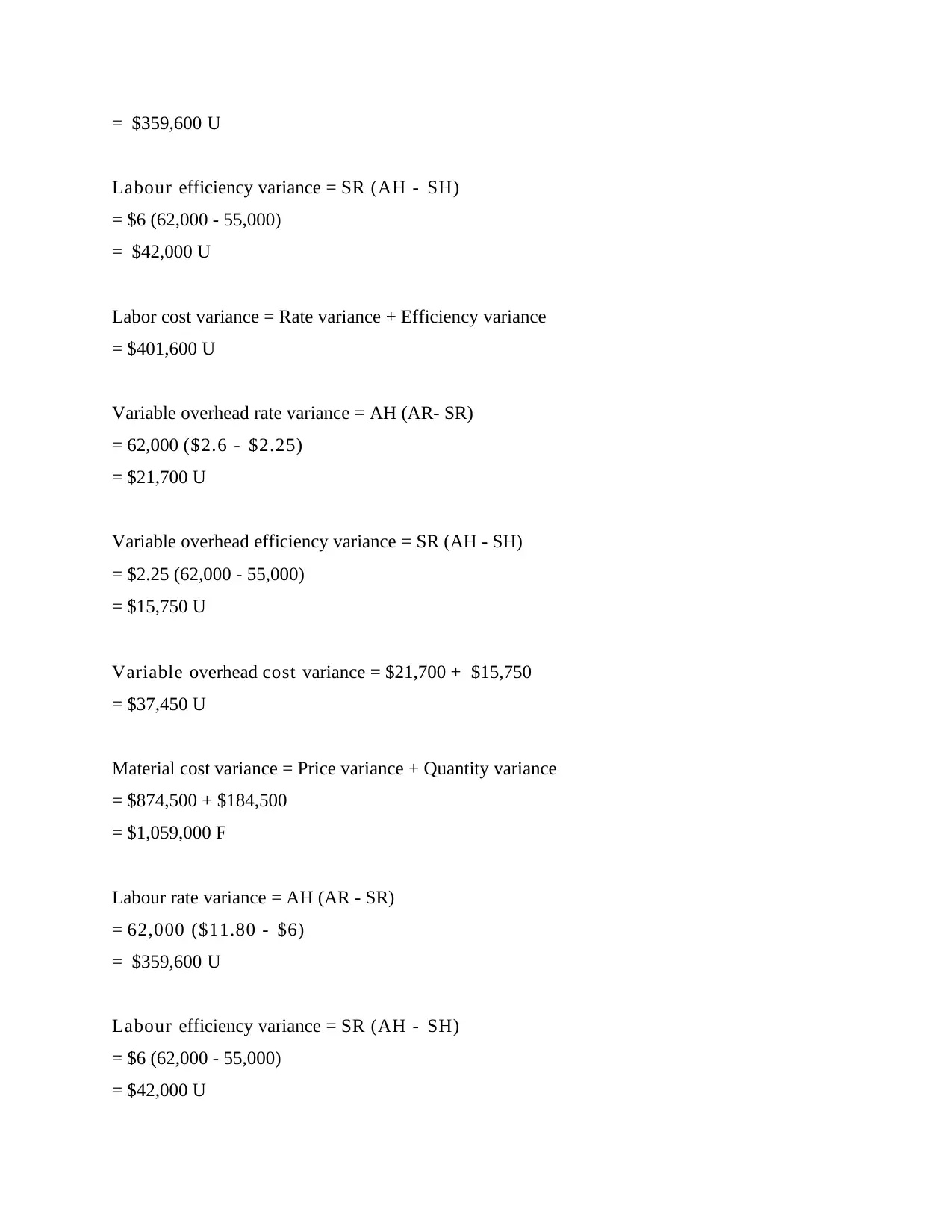
= $359,600 U
Labour efficiency variance = SR (AH - SH)
= $6 (62,000 - 55,000)
= $42,000 U
Labor cost variance = Rate variance + Efficiency variance
= $401,600 U
Variable overhead rate variance = AH (AR- SR)
= 62,000 ($2.6 - $2.25)
= $21,700 U
Variable overhead efficiency variance = SR (AH - SH)
= $2.25 (62,000 - 55,000)
= $15,750 U
Variable overhead cost variance = $21,700 + $15,750
= $37,450 U
Material cost variance = Price variance + Quantity variance
= $874,500 + $184,500
= $1,059,000 F
Labour rate variance = AH (AR - SR)
= 62,000 ($11.80 - $6)
= $359,600 U
Labour efficiency variance = SR (AH - SH)
= $6 (62,000 - 55,000)
= $42,000 U
Labour efficiency variance = SR (AH - SH)
= $6 (62,000 - 55,000)
= $42,000 U
Labor cost variance = Rate variance + Efficiency variance
= $401,600 U
Variable overhead rate variance = AH (AR- SR)
= 62,000 ($2.6 - $2.25)
= $21,700 U
Variable overhead efficiency variance = SR (AH - SH)
= $2.25 (62,000 - 55,000)
= $15,750 U
Variable overhead cost variance = $21,700 + $15,750
= $37,450 U
Material cost variance = Price variance + Quantity variance
= $874,500 + $184,500
= $1,059,000 F
Labour rate variance = AH (AR - SR)
= 62,000 ($11.80 - $6)
= $359,600 U
Labour efficiency variance = SR (AH - SH)
= $6 (62,000 - 55,000)
= $42,000 U
Paraphrase This Document
Need a fresh take? Get an instant paraphrase of this document with our AI Paraphraser
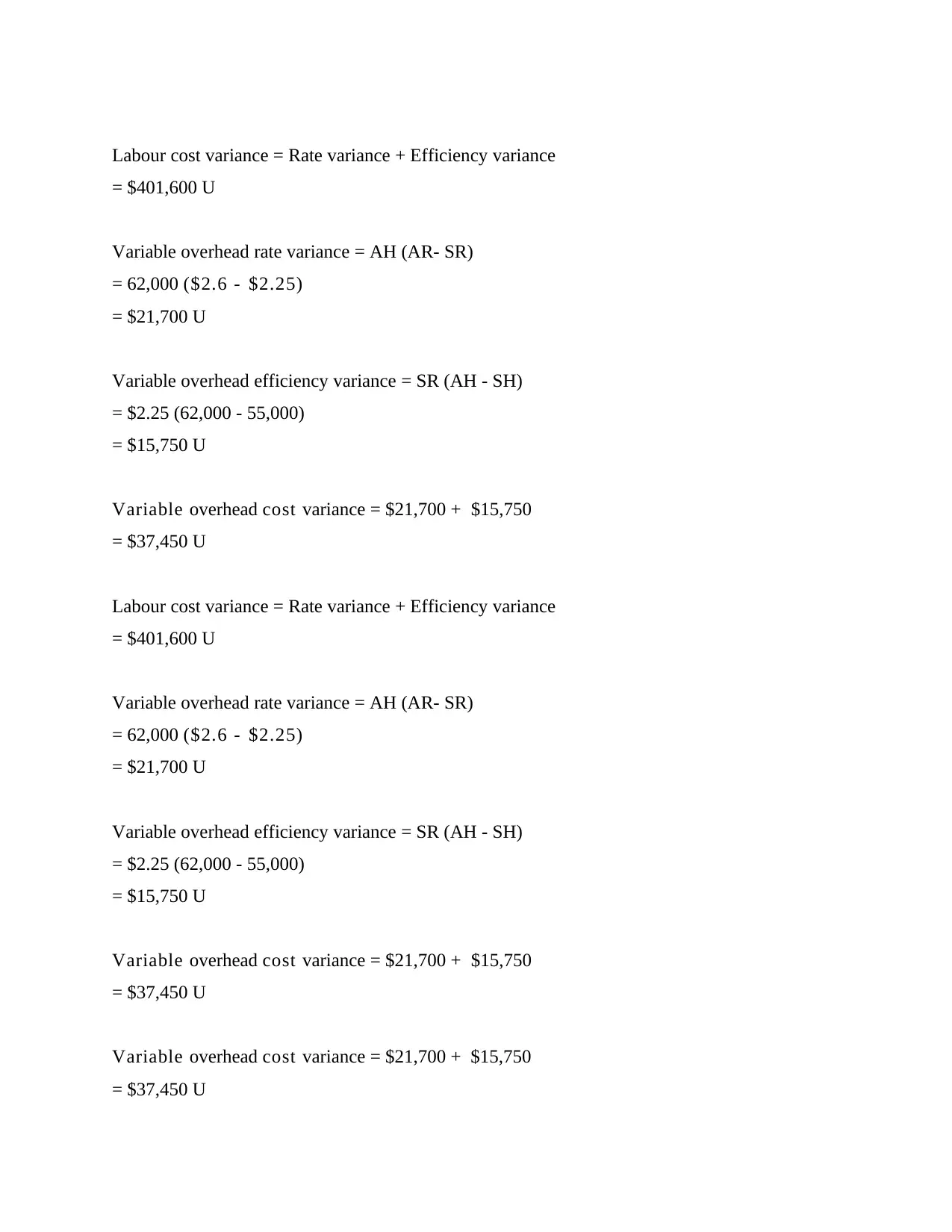
Labour cost variance = Rate variance + Efficiency variance
= $401,600 U
Variable overhead rate variance = AH (AR- SR)
= 62,000 ($2.6 - $2.25)
= $21,700 U
Variable overhead efficiency variance = SR (AH - SH)
= $2.25 (62,000 - 55,000)
= $15,750 U
Variable overhead cost variance = $21,700 + $15,750
= $37,450 U
Labour cost variance = Rate variance + Efficiency variance
= $401,600 U
Variable overhead rate variance = AH (AR- SR)
= 62,000 ($2.6 - $2.25)
= $21,700 U
Variable overhead efficiency variance = SR (AH - SH)
= $2.25 (62,000 - 55,000)
= $15,750 U
Variable overhead cost variance = $21,700 + $15,750
= $37,450 U
Variable overhead cost variance = $21,700 + $15,750
= $37,450 U
= $401,600 U
Variable overhead rate variance = AH (AR- SR)
= 62,000 ($2.6 - $2.25)
= $21,700 U
Variable overhead efficiency variance = SR (AH - SH)
= $2.25 (62,000 - 55,000)
= $15,750 U
Variable overhead cost variance = $21,700 + $15,750
= $37,450 U
Labour cost variance = Rate variance + Efficiency variance
= $401,600 U
Variable overhead rate variance = AH (AR- SR)
= 62,000 ($2.6 - $2.25)
= $21,700 U
Variable overhead efficiency variance = SR (AH - SH)
= $2.25 (62,000 - 55,000)
= $15,750 U
Variable overhead cost variance = $21,700 + $15,750
= $37,450 U
Variable overhead cost variance = $21,700 + $15,750
= $37,450 U
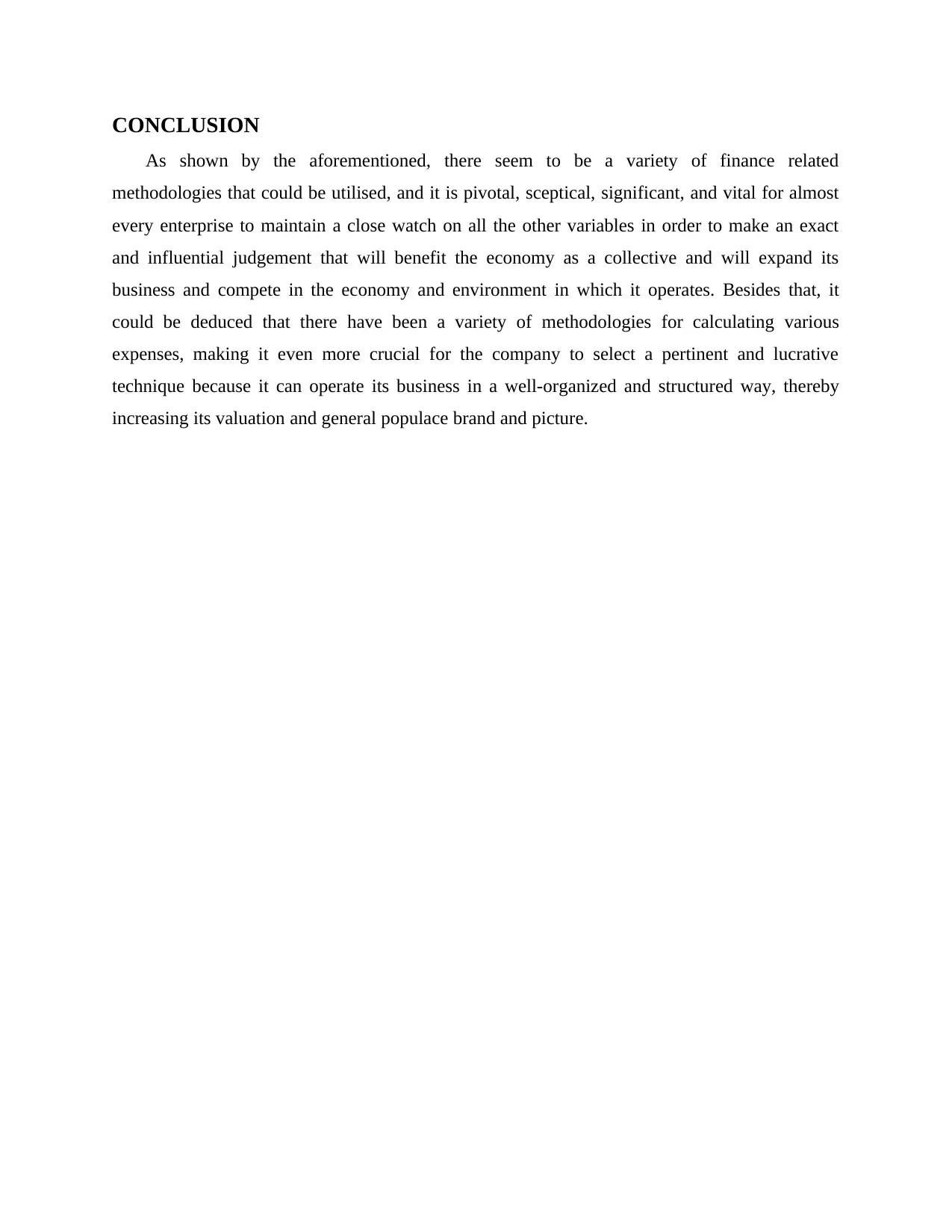
CONCLUSION
As shown by the aforementioned, there seem to be a variety of finance related
methodologies that could be utilised, and it is pivotal, sceptical, significant, and vital for almost
every enterprise to maintain a close watch on all the other variables in order to make an exact
and influential judgement that will benefit the economy as a collective and will expand its
business and compete in the economy and environment in which it operates. Besides that, it
could be deduced that there have been a variety of methodologies for calculating various
expenses, making it even more crucial for the company to select a pertinent and lucrative
technique because it can operate its business in a well-organized and structured way, thereby
increasing its valuation and general populace brand and picture.
As shown by the aforementioned, there seem to be a variety of finance related
methodologies that could be utilised, and it is pivotal, sceptical, significant, and vital for almost
every enterprise to maintain a close watch on all the other variables in order to make an exact
and influential judgement that will benefit the economy as a collective and will expand its
business and compete in the economy and environment in which it operates. Besides that, it
could be deduced that there have been a variety of methodologies for calculating various
expenses, making it even more crucial for the company to select a pertinent and lucrative
technique because it can operate its business in a well-organized and structured way, thereby
increasing its valuation and general populace brand and picture.
⊘ This is a preview!⊘
Do you want full access?
Subscribe today to unlock all pages.

Trusted by 1+ million students worldwide
1 out of 13
Related Documents
Your All-in-One AI-Powered Toolkit for Academic Success.
+13062052269
info@desklib.com
Available 24*7 on WhatsApp / Email
![[object Object]](/_next/static/media/star-bottom.7253800d.svg)
Unlock your academic potential
Copyright © 2020–2025 A2Z Services. All Rights Reserved. Developed and managed by ZUCOL.




